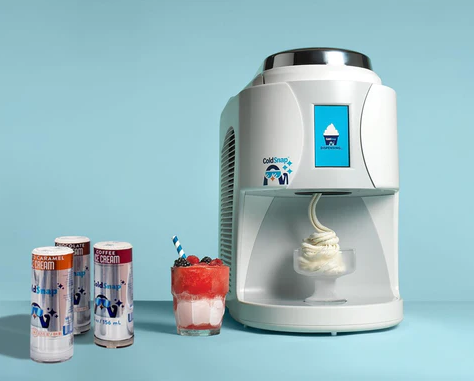It’s a hot summer afternoon, you’re all sandy from a day at the beach with friends, and you’re ready for a cool treat. You flip-flop by a shack lit up by a giant ice cream cone emblazoned with neon lights. You turn to your friends, “Anyone for soft serve?”
Soft serve evokes feelings of quintessential American summer days. Some of our earliest childhood memories involve grabbing a cone of soft serve from a neighborhood ice cream truck or creamery. Our infatuation with the sweet treat carries on into adulthood, as we pass the tradition down to younger generations.
But what started the soft serve phenomenon? Where did soft serve come from and how did technology pave the way for revolutionary mechanisms like the ColdSnap® ice cream machine to give us access to fresh, at-home, single-serving ice cream? Let’s dig in to learn the history of soft serve in a snap!
Ice Cream’s Humble Beginnings
To know how we got soft serve, we have to start with the history of ice cream itself. Although no specific inventor or date of discovery has been credited, historians estimate that the origins of ice cream go back to roughly second-century B.C.E. “Do we know what the first flavor of ice cream was?” you may ask. Well, it’s said that Alexander the Great asked for honey and nectar in his ice concoction, so that’s a start!
Until around 1660, ice cream was only enjoyed by royalty across ancient civilizations and kingdoms. At the first cafe in Paris, Café Procope, the Sicilian Procopio introduced a frozen recipe blending milk, cream, butter, and eggs. As ice cream became publicly available, it was typically only relished by the elite. It wasn’t until the 1850s when an American milk dealer named Jacob Fussell began manufacturing vanilla ice cream that everyone, regardless of socioeconomic standing, could afford.

Say Hello To Soft Serve
Ice cream took America by storm. People from every region scooped up spoonfuls of the delicious dessert. As the 20th century progressed, so did the significance of ice cream in America, along with the evolution of the frozen treat. In 1926, Charles Taylor of Buffalo, NY patented an automatic ice cream maker that is considered to be the first soft serve machine. This machine produced a frozen dessert that was softer and less dense – a result of air introduced during the freezing process.
The soft serve bug spread. In 1934 Tom Carvel began serving melted ice cream from a broken-down truck. It was so popular that he then developed a soft serve formula, as well as a patented low-temperature ice cream machine. Dairy Queen quickly followed the trend and produced its own soft serve, too.
A New Era Of Ice Cream
Soft serve soon became widely popular as the preferred way to consume ice cream for Americans. In the late 1940s, the treat boomed as it became more accessible. A United States distributor, Mister Softee, developed a soft-serve recipe that was compatible with machines. As the 1960s rolled on, the company sold its product from step vans, allowing the driver to conveniently dispense soft serve from a side window to eager customers. Equipped with bells to signal their approach, the musical accompaniment of these vans would later evolve into the ice cream truck songs that delight children (and adults!) across the country.

Enter into the 21st century, and the love of soft serve has far from diminished. Now offered in countless flavors from strawberry to peanut butter, its iconic airy consistency and production process have not changed much. It continues to be much warmer, frozen at about −4°C (25°F) compared to -25°C (-13°F) for hard ice cream. Any colder and soft serve would lose its unique texture.
An Ice Cream Revolution Is Underway
Ice cream enthusiasts like ourselves want to keep enhancing the dessert, as technology shows us just how endless the possibilities are. That’s why ColdSnap is dedicated to giving consumers a revolutionary frozen treat experience. If you enjoy rich and decadent ice cream, we are here for you. ColdSnap’s proprietary technology serves up the creamiest premium ice cream with 14% milk fat at soft serve temperature.

Additionally, the ColdSnap ice cream maker solves one of the biggest problems associated with soft serve machines – cross-contamination. Since the product never touches the machine during the mixing, freezing, or dispensing processes, ColdSnap’s ice cream machine stays clean and free from cross-contamination.
With the ColdSnap system, all you need to do is place a room temperature, single-serving pod into the machine, wait two minutes, and your premium frozen treat is ready. All of our dairy and non-dairy products from ice cream to frozen cocktails are freshly frozen on demand.
Stay tuned for the latest news on when a ColdSnap system is available near you!
Get the Scoop
Stay in the loop on all things ColdSnap with our newsletter.
Categories
Recent Posts
- ColdSnap Partners With Foodbuy to Deliver On-Demand Frozen Treats to Foodservice Operators
- Your Morning Just Got a Whole Lot Smoother: How to Make a Delicious & Healthy Smoothie with ColdSnap
- 7 Reasons Every Golf Course Needs a ColdSnap Machine
- Empowering Students with Self-Serve Frozen Treats — No Hassle, All Joy
- Ice Cream on Demand…From a Can??


